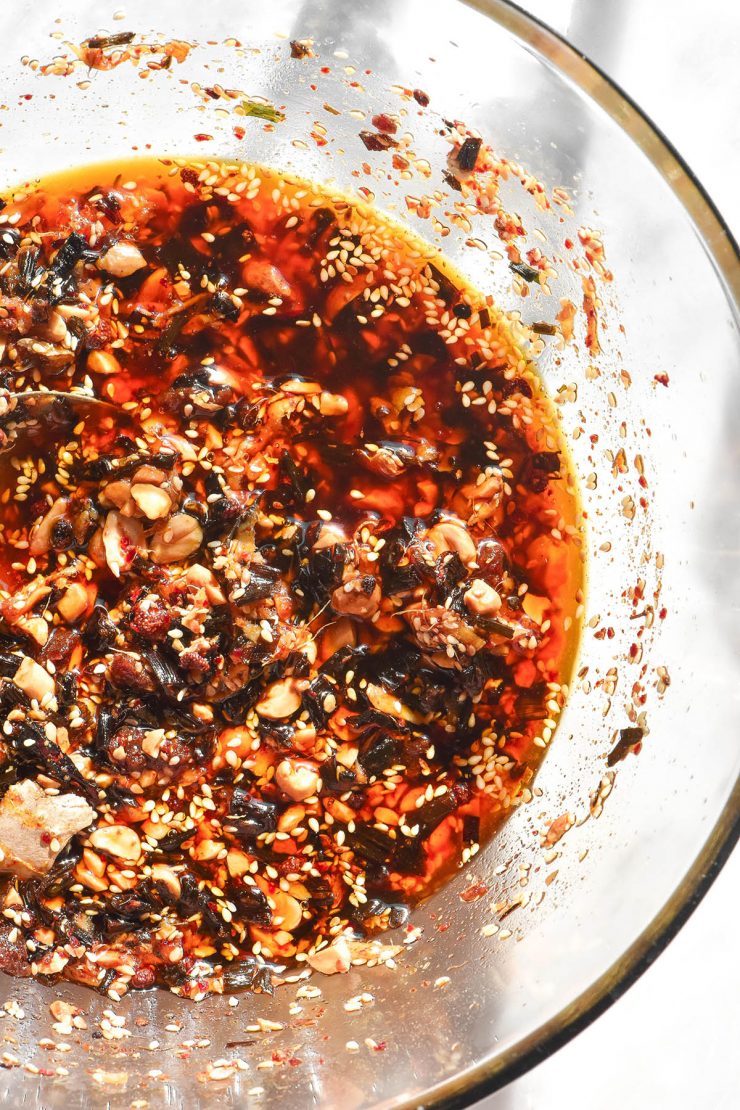
I have been eyeing off chilli crisp for a while now. As someone who feels sick after eating onion and garlic, I had never tried it to understand the hype. As I was developing some dumpling and wonton recipes, though, it occurred to me that I should give a low FODMAP chilli crisp a whirl. Oh boy! I’ve been missing out, and if you’re low FODMAP, you have been too.

Low FODMAP chilli crisp
This low FODMAP chilli crisp uses spring onion greens and a low FODMAP quantity of chilli flakes for the flavour base. The spring onions are slowly fried in oil to create crispy, delicious pieces of spring onion.
The oil is then made aromatic with the help of star anise, cinnamon sticks and cardamom pods for depth of flavour. The spring onion greens impart their onion taste too.
Extra crisp comes in the form of peanuts and sesame seeds. These are mixed with Sichuan peppercorns, miso paste, asafoetida powder and a bit of mushroom powder. Once the hot oil is poured over the crunchy base, the oil is finished with salt, sugar and some black rice vinegar.
All in all, this low FODMAP chilli crisp is a flavour bomb that goes perfectly on anything. Soup, a bowl of rice, pasta – whatever you like. The possibilities are endless!
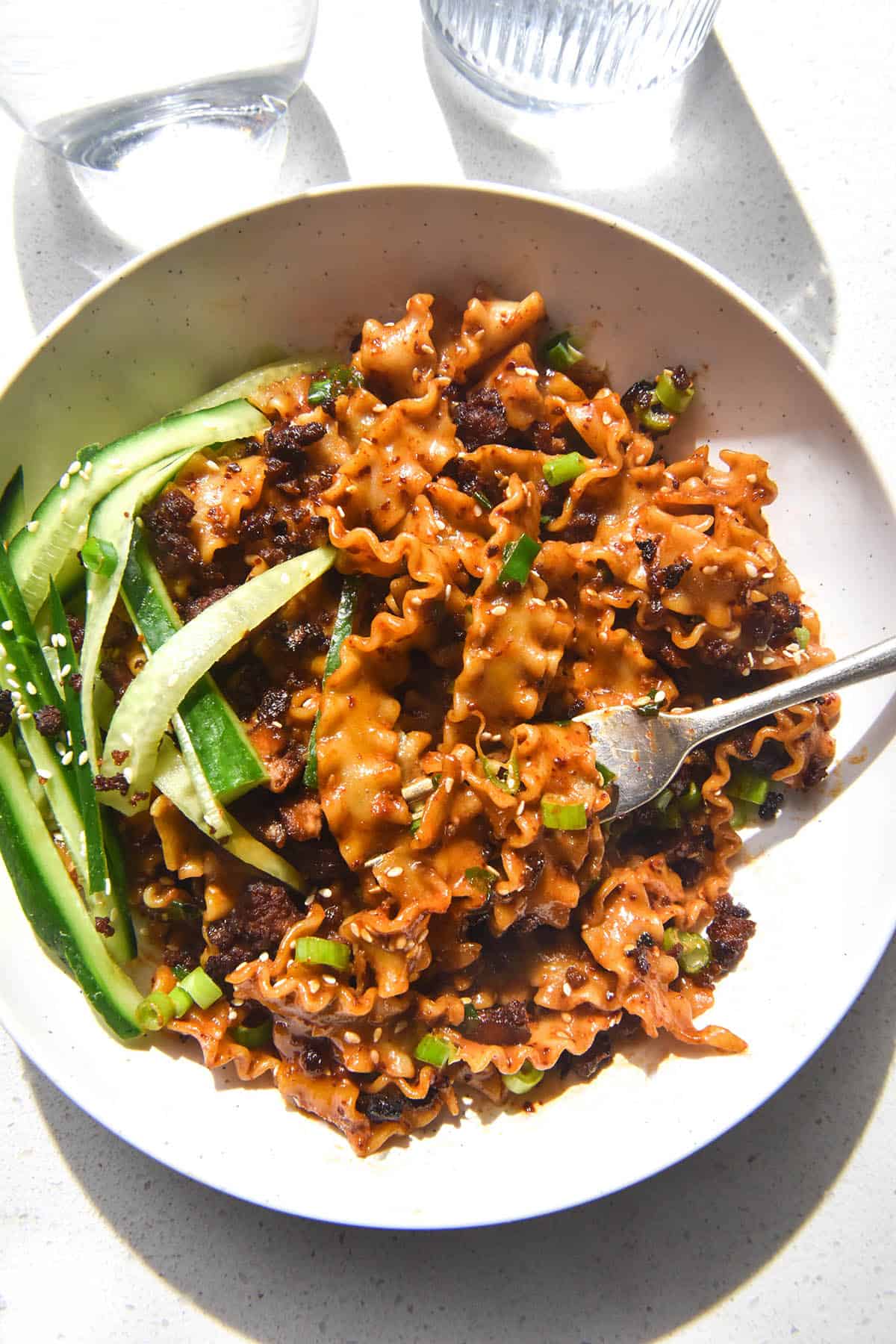
FODMAP notes
These FODMAP thresholds were last reviewed in late June 2025. They will be periodically reviewed to ensure they remain up to date with the Monash app.
The main components of this chilli crisp that require discussion are the chillies themselves, along with the nuts.
Whole red chillies are low FODMAP in 28g or approximately 1 medium red chilli per serve. They are lower FODMAP than dried chillies, which is why they are included in this crisp. See the notes in the section below on adding heat while on a low FODMAP diet.
Korean red chilli flakes are low FODMAP in 2g (1 teaspoon) serves. They contain moderate amounts of fructose in 5g (2 teaspoon) serves. This chilli crisp uses 8-10g and makes a very large batch.
Sesame seeds are low FODMAP in 11g serves or approximately 1 tablespoon per person. Monash currently doesn’t list an upper limit. Either way, this recipe uses 35g and makes a very large batch.
Finally, the peanuts. Peanuts are low FODMAP in 28g serves or approximately 32 nuts. However, Monash has previously said that they contain only trace amounts of FODMAPs, and can be eaten freely and according to appetite. If they update the entry for peanuts, I will update this post. FODMAP Everyday lists peanuts as being low FODMAP in 600g serves.
FODMAP nitty gritty
This chilli crisp makes around 550g or 2 Australian cups. My estimate for one serve would be 2 or 3 Australian tablespoons (3 tablespoons equal 1/4 Australian cup).
If you use 2 tablespoons, this chilli crisp serves 12.
If you use 3 tablespoons per serve, this chilli crisp serves 8.
For a batch that is serving 12, you could safely use up to 24g of Korean chilli flakes. To be on the safe side (considering the fresh chilli) I would suggest 20g.
For a batch that is serving 8, you could safely use up to 16g of Korean chilli flakes. To be on the safe side (considering the fresh chilli) I would suggest 12gish.
Of course, none of this takes into account the fructose content of what you’re putting the chilli crisp on. Keep that in mind if you malabsorb fructose – it will need to be served with a low fructose meal.

Important safety tips for your low FODMAP chilli oil
Ginger and spring onions in oil present a botulism risk. A small risk, but a risk nonetheless (given that botulism can be fatal). In order to minimise any risk, the following tips should be adhered to.
- Ensure the spring onions are cooked until completely crispy (but not burnt). This helps minimise the risk from the spring onion.
- The ginger is raw, so there’s not much we can do about that. If you’re concerned, you can cook the ginger with the spring onions or omit.
- Don’t leave the oil on the bench for hours to cool. Cool it quickly and then place it straight into the fridge. Botulism spores can grow at room temperature.
- To be on the safe side, eat the chilli crisp relatively quickly after using it. Some health authorities suggest 10 days, others suggest only 4 days. Some people on Reddit say the threat is overhyped. Do what you are comfortable with.
- This batch of chilli crisp makes quite a lot. Don’t panic that you won’t be able to get through it, though, because you can easily freeze it! I recommend freezing it in small containers and serving sizes. This way you can defrost what you need each time. Use the frozen and defrosted batch within the 4-10 day timeframe, then move onto your next container.
- If you would prefer, you can omit the spring onions and ginger. I would still recommend following all precautions, though.
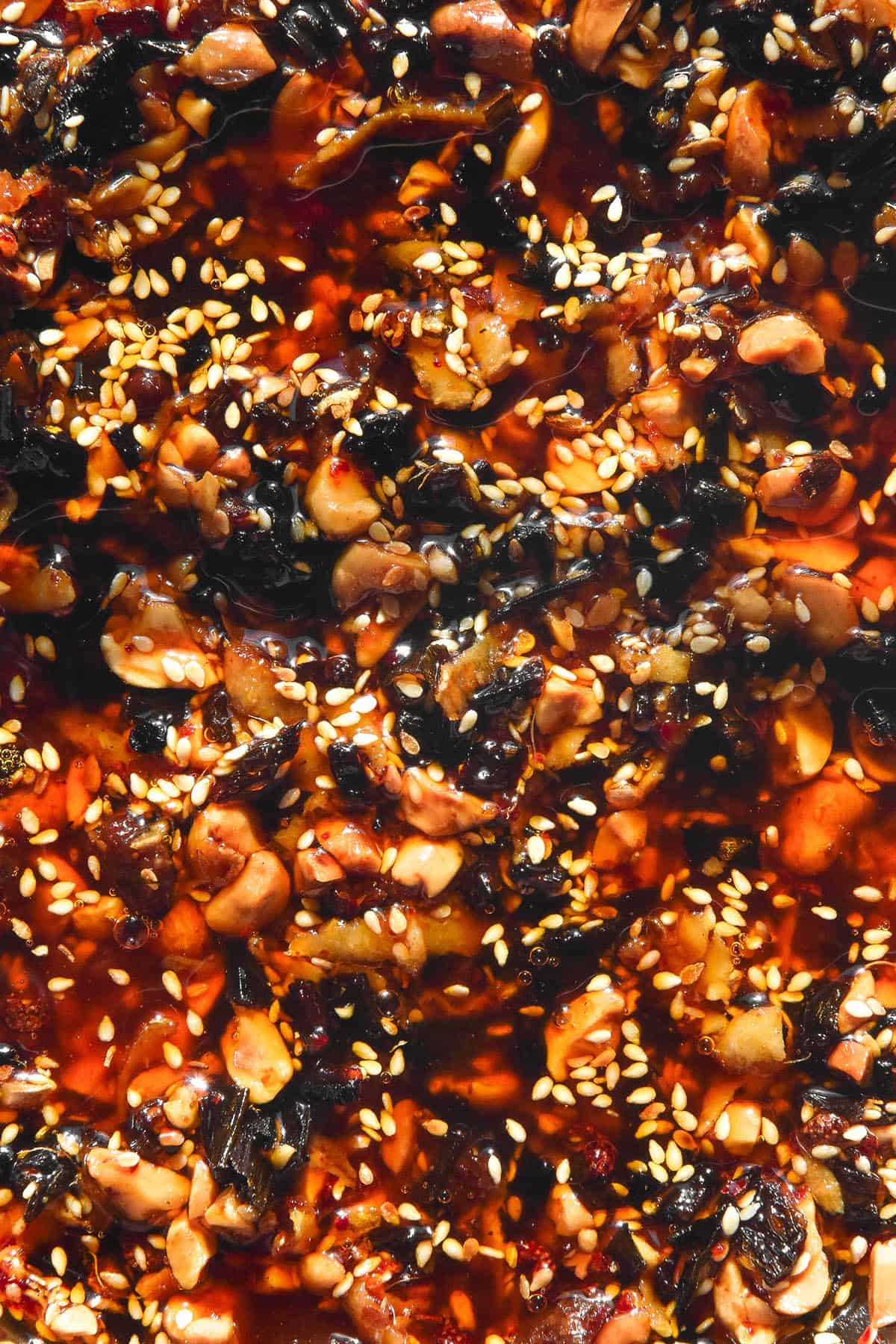
Tips for making your low FODMAP chilli crisp
My first and most important tip is to ensure you read the safety tips above. Chilli crisp is delicious and well worth making, but good food hygiene is important here.
My second tip is to measure out all your ingredients before you get started. It will make the process seamless and speedy. Plus, it negates the risk of burning your spring onions while you frantically measure out peanuts.
My third tip pertains to the cooking process. The spring onions can go from crispy to burnt in seconds. Cook the oil on a low and slow temperature and watch it very closely as it finishes cooking.
On the note of the spring onions – ensure they are cooked through and completely crispy but not burnt. They should add cooked onion flavour and crunch, not unpleasant charcoal flavour. Watch them really closely and take a few out of the oil to test. They should be crunchy and taste a bit like fried shallots.
We have discussed botulism safety above, but a note on regular food safety. Ensure the jar you use to store your chilli oil is thoroughly cleaned and dried. If you need advice on sterilising jars, see Cornersmith’s website and post.

Adjusting the spice level on a low FODMAP diet
Some people love a good hit of chilli, particularly in something like a chilli crisp.
Fresh chillies tend to contain fructans in moderate and high serves, while dried chillies tend to contain fructose. Because the fructose is concentrated during the drying process, dried chillies have very small FODMAP thresholds. This can make it more difficult to achieve the level of spice you are accustomed to.
So, I have found a few ways to get around this during the development of this recipe and also my low FODMAP chilli crisp recipe. Without further ado:
- Add plenty of fresh finely grated ginger. Ginger has a fieriness to it that can help replicate spice, particularly when paired with some chilli.
- Use more fresh chillies and less dried chillies. Red chillies are low FODMAP in a whole medium chilli (28) per serve. In 33g serves, they contain moderate amounts of fructans.
- Use chilli flakes or a hot variety of chilli powder instead of a milder variety like Korean red chilli powder or Kashmiri chilli. The former are spicier varieties that actually have a lower FODMAP threshold (not by much, but still!). You can add some paprika to try and mimic the vibrant red colour, because spicier chilli flakes tend to be a muddy brown rather than a vibrant red.
- Add plenty of pepper. Black and white pepper add spiciness in large serves. Monash doesn’t list an upper quantity for a low FODMAP serve of pepper.
- I haven’t tried this, but pickled chillies (like pickled jalapeños) are lower FODMAP. If you need extra heat, you can experiment with adding some pickled chillies to the mix.

Non-negotiable ingredients for your low FODMAP chilli crisp
Obviously, chilli in some form is at the top of this list. This is the whole point! See the notes above for tips on adding extra heat while on a low FODMAP diet.
Personally, I think Sichuan peppercorns are a non-negotiable. They have a numbing quality that is so inherent to good chilli oil. You can buy them cheaply online or in person at Asian grocers and supermarkets with a great spice selection. Worth the time taken to source, I promise!
Peanuts are a low FODMAP nut that goes perfectly in this chilli oil. Using the same volume of sesame seeds would take this into a higher FODMAP threshold, unfortunately. So at the moment the peanuts are a non-negotiable. If and when I discover a replacement for those with nut allergies, I will update the post. I have seen some recipes use soy nuts but I haven’t managed to track any down.
Personally, I feel that the miso paste is just so good here. When added to the crisp it doesn’t 100% dissolve, which means you get little salty pockets of umami in the crisp.
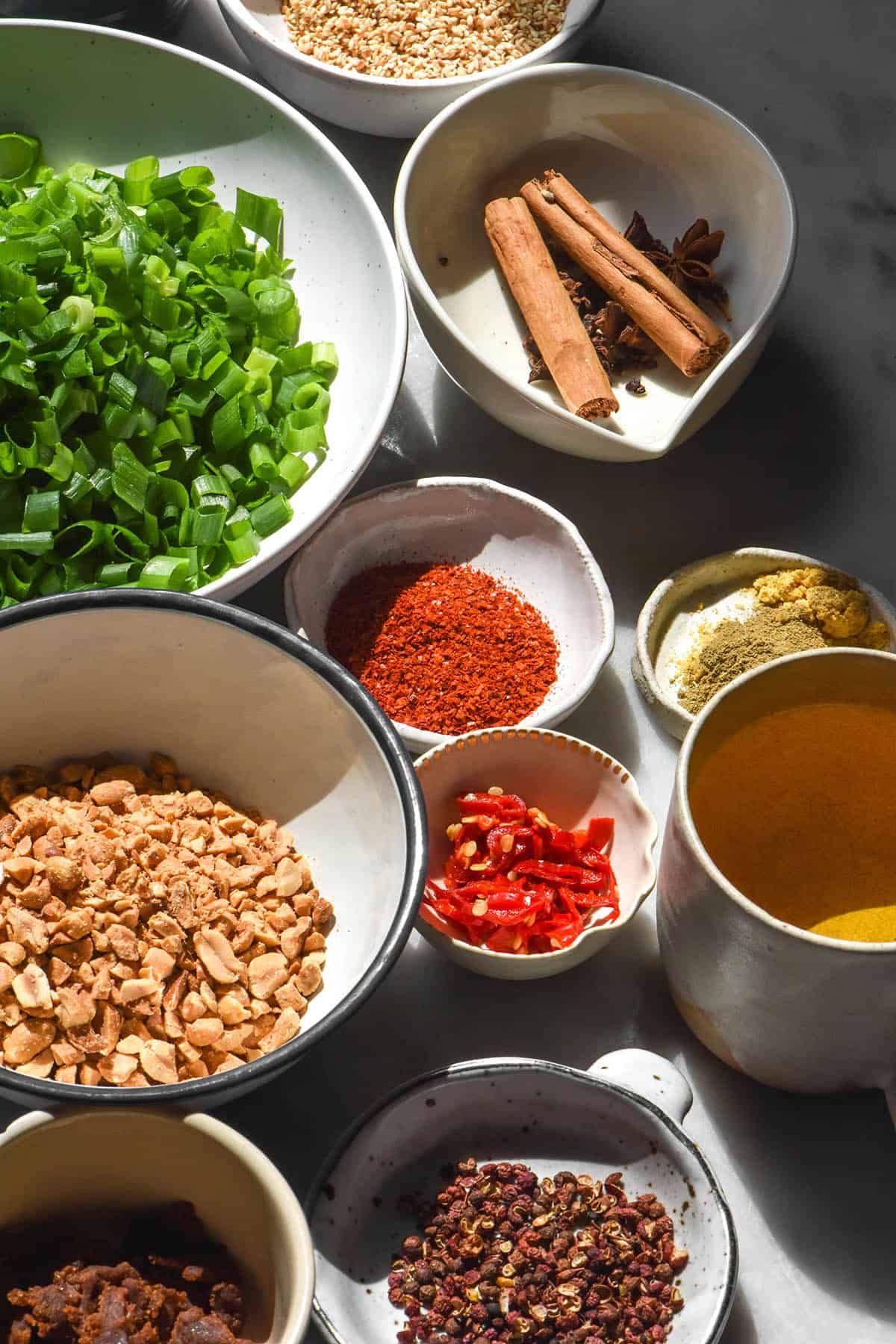
Optional ingredients for extra flavour
So, we have been through the non-negotiables. I thought I’d also briefly list the low FODMAP options for adding extra flavour to this delicious crisp.
- MSG powder. Add it if you want and don’t if you don’t want. Simple.
- Mushroom powder. I have porcini powder which has lasted me forever. A small amount adds a savoury deliciousness.
- Makrut lime leaves or lime zest for a South Asian twist. A splash of regular or vegan fish sauce could also round out the oil.
- I’ve seen recipes online suggest herbs can be added. I haven’t tested this myself and I’m not sure if you’d add them to the oil or the crisp but an interesting idea nonetheless.
- A few drops of liquid smoke for an extra layer of flavour.
- Garlic infused oil. Personally, I didn’t find this to be worth the extra effort as there’s so much flavour as is, but it’s an option.
- Orange zest, lemon zest or lime zest.
- Black cardamom instead of regular cardamom.
- I plan to try using my low FODMAP pickled garlic in here ASAP.
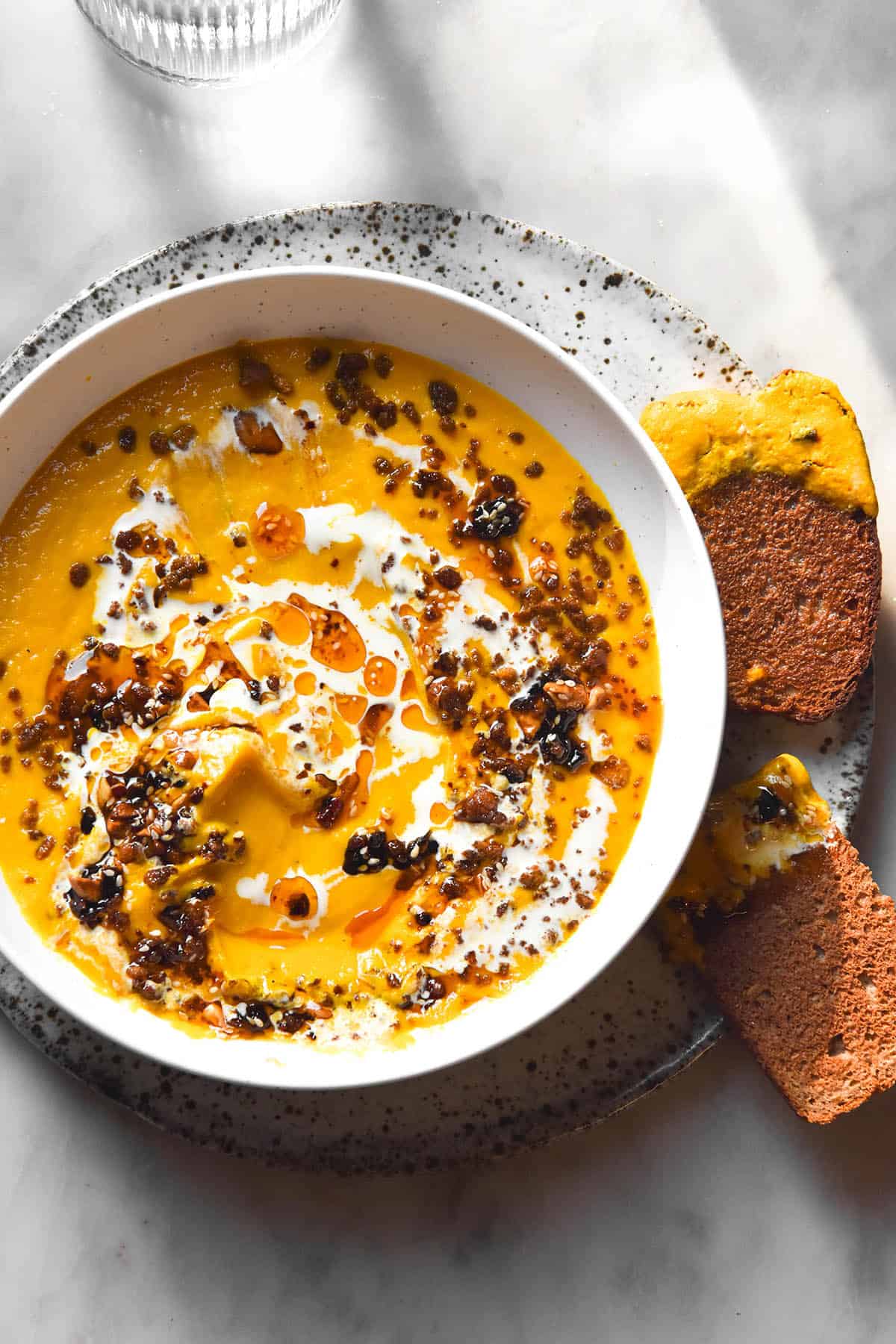
Where to use your low FODMAP chilli crisp
Once you make a batch of chilli crisp, you will quickly realise that there’s no point me answering this question. Chilli crisp goes on everything. It legitimately even goes on vanilla ice cream. However, a few recipes and dishes that I think would be perfect:
- In my low FODMAP dumpling sauce (or just on dumplings)
- In my low FODMAP chilli oil noodles
- Drizzled over a bowl of rice and greens
- Drizzled on fried eggs
- In any pasta dish you think it would suit
- In mayo or salad dressings
- Drizzled over crispy potatoes
- Atop soup (I love it in my low FODMAP carrot soup)
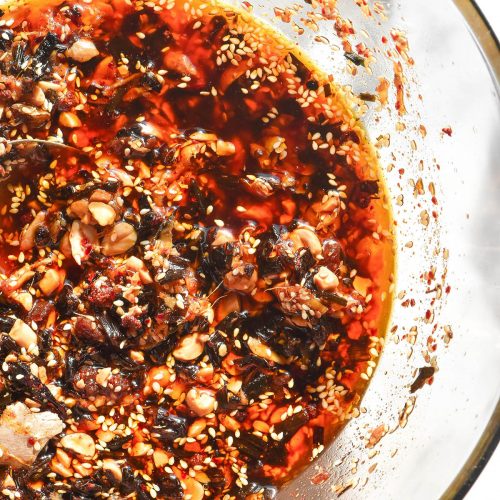
Low FODMAP chilli crisp
Ingredients
- 375 ml (1 1/2 cups)* vegetable oil
- 100-125g (1 large bunch) spring onion greens washed, thoroughly dried and finely sliced
For the infused oil:
- 4 star anise
- 5-10 cardamom pods crushed
- 1 cinnamon stick
- 1-3 whole red chilli finely sliced
- 1 tablespoon Sichuan peppercorns 5g
For the crisp:
- 20-50 g fresh ginger match-sticked or grated
- 100 g (3/4 cup)* toasted and chopped peanuts
- 35 g (1/4 cup)* toasted sesame seeds or extra peanuts
- 8-10 g (1 – 1 1/4 tablespoons)* Korean red chilli flakes
- 1 tablespoon miso paste gluten free if it needs to be
- 1/2 teaspoon cumin powder
- 1/4 -1/2 teaspoon asafoetida powder to your tastes (optional)
To finish:
- 2 teaspoons sugar to taste
- 1 teaspoon salt to taste
- 2 teaspoons black rice vinegar optional and to your tastes
Instructions
- Place the oil and spring onions in a medium pot over a medium heat. Cook for 5-15 minutes until the spring onion greens and golden brown and crispy. Assess the heat, turning it down if need be. Continue to cook until the spring onions are a deep brown (but not burnt!) and shrivelled. If you take a few out of the oil (and allow to cool before touching) they should feel super crispy. This is as important for taste as it is for food safety, so don’t rush this step (see notes).
- The spring onion greens will crisp up further when they are removed from the oil. Once they are browned and crisped to your liking, scoop them out of the oil with a slotted spoon and place onto some paper towel. Set aside.
- Turn the heat to low medium. Add the ingredients for the infused oil to the pot. Continue to cook for 5-10 minutes or until your oil is super aromatic.
- Combine the ingredients for the crisp in a medium/large heatproof bowl.
- Once the infused oil is fully infused, pour it over the crisp ingredients in the heatproof bowl. The mixture should sizzle and the chilli should bloom to be a bright red colour (this is why a bright red chilli like Korean/gochugaru or Kashmiri is important).
- Add the crispy spring onions back into the mix and stir to combine. Allow to cool slightly before adding the finishing ingredients to your tastes.
- Make sure you cool the oil quickly and transfer to a sterilised jar in the fridge.
- Consume within 4-10 days and freeze the remainder in small batches to be defrosted at your leisure.
Notes
- Read the post for FODMAP notes, tips and tricks. Worth your time, I promise.
- Ensure the spring onions are cooked until completely crispy (but not burnt). This helps minimise any botulism risk from the spring onion (see body of post).
- The ginger is raw, so there’s not much we can do about that. If you’re concerned, you can cook the ginger with the spring onions and fishing it out if it cooks prior to the spring onion.
- Don’t leave the oil on the bench for hours to cool. Cool it quickly and then place it straight into the fridge. Botulism spores can grow at room temperature.
- To be on the safe side, eat the chilli crisp relatively quickly after using it. Some health authorities suggest 10 days, others suggest only 4 days. Some people on Reddit say the threat is overhyped. Do what you are comfortable with.
- This batch of chilli crisp makes quite a lot. Don’t panic that you won’t be able to get through it, though, because you can easily freeze it! I recommend freezing it in small containers and serving sizes. This way you can defrost what you need each time. Use the frozen and defrosted batch within the 4-10 day timeframe, then move onto your next container.

Hi Goergia,
I am really into Korean food, fermenting my own kimchi and traditional bean and chilli pastes. Their chilli flakes (coarsely ground) come in a variety of “spiciness”. The English translations on the packets is quite often non-existent, poor or ineffective. I have been learning Hangeul to deal with it. Korean chilli flakes are known as Gochugaru (고추가루). Mild is (deol-maewoon gochu-garu 덜매운 고춧가루) and hot (maewoon gochu-garu 매운 고춧가루), or also botongmat (보통맛), meaning medium spicy, or maeunmat (매운맛), meaning extra spicy. There is also chilli powder (finely ground) in different heat levels, but that is usually used for making gochujang (a fermented chilli paste). If any of you take the Hangeul lettering I’ve provided when shopping it should help to buy chilli flakes that suit your heat tolerances.
This is incredible information, thanks Nic! I always seem to end up with a fairly mild bag of chilli flakes so I will definitely write this down next time I need some!